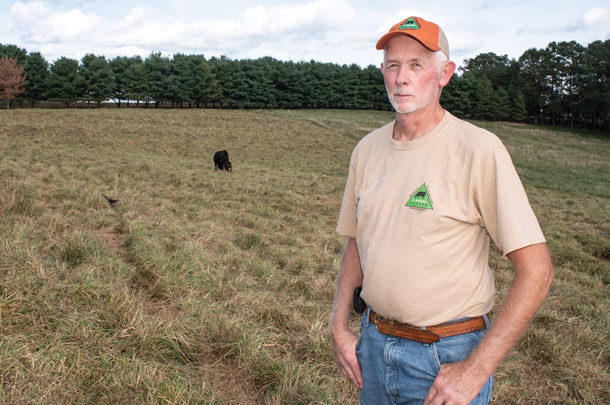In 2004, the Westminster, South Carolina cattleman’s numbers told him too many of his cows were open. “I knew enough to know 65% preg rates weren’t good business and sent all my data to John Andrae.” He also knew enough to call the right man for the job. At the time, Andrae, who is now Clemson University experiment station assistant director, was the forage agronomist at the University of Georgia (UGA). Andrae enlisted the help of UGA professor emeritus Carl Hoveland.
When Hoveland was at Auburn University, he discovered Kentucky 31 fescue harbors a toxic endophyte that negatively impacts cattle health and performance. It puts a “whammie” on fertility for both cows and bulls, cuts down on milk production, hits gains and constricts the blood vessels in cattle. That, along with the rough hair coat it can also cause, means cattle have trouble handling heat in the summer. Cold weather can bring fescue foot. In severe cases, their hooves can actually slough off.
“I had just planted Kentucky 31 fescue in a pasture. When Dr. Andrae and Dr. Hoveland asked me what I had planted, they just said, ‘Oh no.’”
After Hoveland’s research came to light, forage breeders figured out a way to remove the toxic endophyte from the forage. However, they later found that same endophyte gave fescue its hardiness. The endophyte-free version simply didn’t hold up under grazing pressure and drought. Fortunately, their next step was finding a way to take the toxin out of the endophyte while leaving the hardiness factor in place.
Davis is convinced. When all but 190 acres of his 460-acre operation were in novel endophyte fescue, his conception rates had risen to 75% to 80%, but that wasn’t good enough. “I had a group of 50 cows, but some were first-calf heifers. We were breeding them in April and May, when the Kentucky 31 had seed heads.”
The University of Missouri extension state forage specialist Craig Roberts says that’s when Kentucky 31 is at its worst. “Most toxin is down in the bottom 2 inches of the plant most of the year, which is often grazed, but it is in the seed heads when it has seeds.”
Those conception rates, along with data he collected on his stocker and finishing calves from his 160-cow Angus-Brangus-Simmental cross herd, convinced Davis to convert or plant the rest of his pastures in novel endophyte fescue.

He says, “With novel endophyte fescue, you are going to get 50 to 75 pounds of additional weaning weight.” This is in spite of the fact that all the calves were on novel endophyte fescue during the preconditioning and stocker phase.
Now his conception rates are also more to his liking, even though he and manager Mike Hall synchronize and A.I. breed the whole herd before they turn the bulls in 10 days later. The total breeding season for heifers is 45 days, and 64 days for cows. Conception rates are in the 90s, while the number of live calves born per cow exposed is in the 80s.
Even with all the advantages, converting a pasture from Kentucky 31 fescue to novel endophyte fescue is neither for the cash-strapped or impatient. Davis estimates costs per acre at around $650. He says $165 an acre covers the actual inputs, while the replacement forage for the time the field is out of commission runs around $485 an acre. He says, “We estimated we got 35% of our usual forage production the first 12 months and 75% the second 12 months.”
However, for the most part, he was able to convert pastures for less than $650 per acre because he was in the process of getting more efficient with fertilizer use, weed control and management intensive grazing on his established pastures, and was clearing additional land and converting it to pasture. Also, since he had fewer cows for part of those conversions, his hay bill wasn’t as steep.
Davis estimates his payback time is five to six years at the most but says, “I really believe it is closer to three to four years.”
If you aren’t in a position to convert all your pastures, Missouri’s Roberts recommends converting 25% to novel endophyte fescue and using those acres for your spring-calving cows. However, he jokes, “It is a gateway drug.”
Matthew Burns, Clemson University beef specialist, says it is also a case of “first things first.” He says, “Producers have to be willing to do the small things right. They need to have a defined breeding season, take soil samples and get the basics of grazing and beef management down. Those things can make a bigger impact on their operation.”
Davis agrees. “Conversion to novel endophyte fescue without good management practices in herd health, managed grazing and controlled breeding is a waste of money,” he says. “However, novel endophyte fescue is a key factor in the improvements in our operation.” ![]()
PHOTO 1: Westminster, South Carolina cattleman Joe Davis says his detailed records tell him weaning weights have increased since he swapped his pastures to novel endophyte fescue.
PHOTO 2: Joe Davis’s Angus-Brangus-Simmental cattle wean heavier calves on novel endophyte fescue. Photos provided by Joe Davis.
If you’d like to learn more about novel endophyte fescue, the Alliance for Grassland Renewal is made up of universities in the fescue belt, (Missouri, Kentucky, Virginia Tech, North Carolina, Clemson, and Georgia), seed companies, related businesses, farmers, non-profit groups including the Noble Foundation, and the USDA Natural Resource Conservation Service. They offer information on quality control, planting and grazing management, financial incentives and opportunities for producer education.
References omitted but are available upon request. Click here to email an editor.
Becky Miller is a freelance writer. Email Becky Miller.
MAKING A STAND
Whether he is converting Kentucky 31 tall fescue pastures to novel endophyte fescue or starting from scratch with newly cleared land, Joe Davis has learned from the experience.
For starters, Davis says, “Do not invest in novel endophyte fescue and fail to invest in a $6 soil test. Our standard is to take soil samples in February.” He puts out lime at least six months before planting but waits for July rains before he puts out phosphorus and potassium in the form of chicken litter.
If he is converting an established pasture to novel endophyte fescue, he sprays before he applies lime. “Burn the pasture off in April, before the seed heads form,” he says.
While the gold standard for converting established Kentucky 31 fescue pastures to novel endophyte fescue is to spray, smother with a cover crop, then spray again before planting, Davis says that didn’t work as well as he wanted on his operation. “Initially we used 2 quarts of glyphosate per acre, then planted brown top millet, then sprayed with another 2 quarts of glyphosate in the fall before planting.”
However, he says, the weeds hid under the millet. So now, he uses 5 quarts of glyphosate in the April application and sprays again with another 5 quarts an acre in six to eight weeks when the weeds emerge. “You can get by with 2 quarts if you don’t have common bermudagrass,” he says.
In September or early October, he sprays again a week before he plants. “Let the weeds get the maximum amount of leaf before they go dormant,” Davis says.
If he is planting on newly cleared land, this spray is the only application. He also smooths and subsoils newly cleared land before spraying, then no-till plants the novel endophyte seed at the rate of 15 to 18 pounds per acre. If it was pasture before, he skips the land preparation and sprays, then no-till plants.
If weeds persist after planting, Davis says, “You can kill broadleaf weeds after the grass comes up with Grazon or 2,4-D. It is critical to wait until the new fescue has four leaves before you spray, though, or it will harm it.”
Next, he prays for rain. “We have grazed lightly as early as January,” he says.













